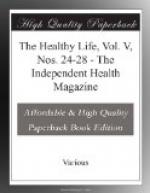If a patient says he can live on less than I ordered for him and if he can pass the physiological tests satisfactorily I know that his bone and muscle weight has been over-estimated. On the other hand, if a patient falls below the physiological tests, though taking and digesting the quantities ordered for him, I conclude that his bone and muscle weight has been under-estimated.
In all cases it is possible to obtain the best
physiological results
and to say when quantities are just right, neither
too much nor too
little.
The evil effects of too much are not serious;
they entail perhaps a
little “gout” or some temporary
loss of freedom from waste products.
The evil effects of too little, if persevered in and continued, especially if some of these effects are attributed to causes which have no real existence, are deadly and dangerous, for they bring on an insidious deterioration both of function and structure which leads by several avenues, often miscalled “diseases,” to death itself.
M.D.
Healthy brains.
Comparatively few health enthusiasts or food reformers realise the necessity for mental, as distinct from bodily, hygiene, yet all real health has its roots in the mind. Moreover, it is only by studying the hygiene of mind that we are enabled to do work in greater quantity and of better quality than we should otherwise be capable of, and to do this without risk of strain on the nerves or injury to health. The articles under this heading put forward some of the elementary laws of mental hygiene.—[EDS.]
Imagination in use.
To some people any talk about the importance of training the imagination of children through their toys, games and studies seems fantastic and trivial. They compare it to feeding them on sweetmeats; they think it means substituting story books for real life and encouraging the easy exercise of fancy for the careful study of fact.
But imagination is not a mere ornament to a life-work; it is rather one of its most valuable and necessary tools. If it did no more than sweeten and adorn the world, it would be well worth having, well worth making considerable sacrifices to attain. But it does more than this. It bears much fruit as well as flowers; fruit that, if it ripens in suitable weather, endures and can be used for the service of man.
There is a wonderful palm-tree, called the Tal or Palmyra palm, which in India and Ceylon supports six or seven millions of people, and “works” also in West Africa, where it is probably native. It gives its young shoots and unripe seeds as food; its trunk makes a whole boat, or a drum or a walking-stick, according to size; hats, mats, thread and baskets—in fact, almost all kinds of clothing and utensils—are made from the split and plaited leaves; gum comes




